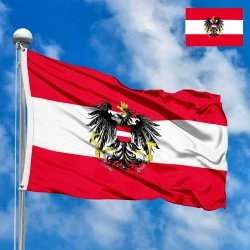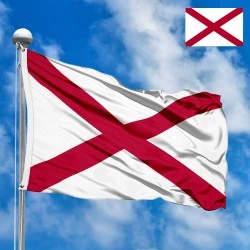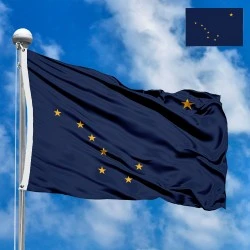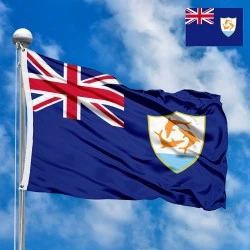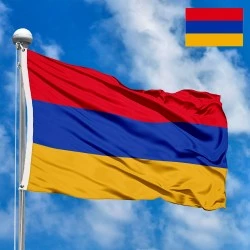Flag of Austria
- Flag Type: State
- Proportions (official): 2:3
- Official name: Republic of Austria
- Local name: Austria
- Sovereignty (year): YES (1955)
- Member of Organizations: UN, European Union
- Country code, territory: AT, AUT, 040
- Capital: Vienna
- Large cities: Graz, Linz, Salzburg, Innsbruck
- Population: 9,104,772 (2024, Statistics Austria)
- Religions: Catholic ~55%, Protestant ~4%, Muslim ~8%, other/none ~33%
- Area (km²): 83 879
- Highest point: Grossglockner (3,798 m)
- Lowest point: Lake Neusiedl (115 m)
- Currency: Euro (EUR, €)
- Languages: German
- Dialing code: +43
- National domain: .at
Flag Information
General information
Demography and Culture
Economy and communications
- All Flags
- Flags of Countries by Continent
-
Flags of Organizations
- Flags of UN countries
- Flags of the European Union countries
- Flags of NATO countries
- Flags of the countries of the Organization of Islamic Cooperation
- Flags of the countries of the Organization of American States
- Flags of the Arab League countries
- Flags of the African Union countries
- Flags of the countries of the Union of South American Nations
- Flags of the Commonwealth of Nations
- Flags of the countries of the Secretariat of the Pacific Community
- Flags of the Nordic Council countries
- Flags of the Caribbean Community
- Flags of the countries of the Association of Southeast Asian Nations
- Flags of the East African Community
- Flags of the countries of the Organization of Turkic States
- LGBT Community Flags
- Historical Flags
- Ethnic Flags
- Flags of the USA (states)
Description
The flag of Austria is a striking and historically rich national symbol, renowned for its simple yet powerful design: three horizontal stripes of red, white, and red. This iconic banner is not just a vibrant display of colors; it embodies centuries of Austrian history, a testament to resilience, and a deep sense of national identity. Its origins are steeped in legend, making it one of the oldest national flags in the world still in use.
Dimensions, Colors, and Arrangement of Elements: The design of the Austrian flag is a model of elegant simplicity, relying on a classic horizontal tricolor pattern.
-
The flag typically has an aspect ratio of 2:3. This means that for every two units of height, the flag measures three units in width, creating a balanced and visually pleasing rectangle.
-
It consists of three horizontal stripes of equal height, each occupying one-third of the flag's vertical dimension. The colors are arranged as follows:
-
The top stripe is red. This vibrant shade of red is a powerful symbol of courage, strength, and valor. Historically, it is often said to represent the blood shed by Austrian patriots in their struggles for freedom and the defense of their homeland. It is a color of passion and determination.
-
The middle stripe is white. The white stripe represents peace, honesty, and purity. It is also frequently interpreted as symbolizing the silver binding of the original battle-stained tunic from the legend of Duke Leopold V, or the snow-capped peaks of the Alps, which are a dominant feature of Austria's landscape. It offers a stark and clear contrast to the red stripes, providing visual balance.
-
The bottom stripe is red, mirroring the top stripe. This repetition reinforces the symbolism of the red color, emphasizing the historical narrative of sacrifice and determination.
-
History of the Flag's Creation and Adoption: The history of the Austrian flag is as captivating as the nation itself, deeply intertwined with the medieval period and a legendary tale.
-
The Legend of Duke Leopold V (12th Century): The most widely accepted and popular origin story for the Austrian flag dates back to the Third Crusade (1189-1192). According to legend, Duke Leopold V of Austria was engaged in fierce fighting during the Siege of Acre. After the battle, his white tunic was so heavily stained with blood that only a white strip remained visible where his sword belt had been. Upon removing his belt, he revealed the distinctive red-white-red pattern. Emperor Henry VI was so impressed by this sight that he granted Leopold the right to bear these colors as his ducal banner. While the exact veracity of this legend is debated by historians, it is a powerful founding myth that has deeply influenced the perception and adoption of the flag.
-
First Documented Use (13th Century): The earliest undisputed historical evidence of the red-white-red banner as the ducal colors of Austria dates to the 13th century. It was indeed used by the Babenberg dynasty, who ruled Austria at the time. The first actual depiction of the red-white-red shield can be found on a seal of Duke Frederick II the Quarrelsome from around 1230.
-
Habsburg Era (13th - 20th Century): When the Habsburgs came to power in Austria in 1278, they adopted the red-white-red colors as their dynastic and territorial emblem. Over the centuries, these colors became increasingly associated with the Duchy, then Archduchy, and later Empire of Austria. Although the official flag of the Habsburg Monarchy often featured the black and yellow colors (from the Habsburg coat of arms), the red-white-red banner remained a significant provincial and later national symbol. It was particularly prominent as a naval ensign and merchant flag.
-
Austrian Empire and Austro-Hungarian Monarchy (1804-1918): During the period of the Austrian Empire (from 1804) and the subsequent Austro-Hungarian Monarchy (from 1867), the official state flag was the black-yellow horizontal bicolour. However, the red-white-red flag remained in widespread use as the civil flag and ensign for the Austrian part of the empire (Cisleithania). It was widely recognized and cherished by the Austrian population.
-
First Austrian Republic (1918-1934): After the collapse of the Austro-Hungarian Monarchy in 1918, and the establishment of the First Austrian Republic, the red-white-red flag was officially re-adopted as the national flag. This marked a definitive return to the ancient colors that symbolized Austria's unique identity, distinct from the broader Habsburg imperial symbols.
-
Austrofascism and Annexation (1934-1945): During the short-lived Austrofascist regime (1934-1938), the flag remained in use. However, with the Anschluss (annexation) by Nazi Germany in 1938, the Austrian flag was abolished, and the swastika flag of Nazi Germany became the official flag.
-
Second Austrian Republic (1945-Present): Following the end of World War II and the liberation of Austria in 1945, the red-white-red flag was immediately reinstated as the national flag of the newly re-established Second Austrian Republic. This was a powerful statement of Austria's renewed independence and its rejection of the Nazi past. The flag's design has remained unchanged since then, a symbol of continuity and renewed national pride.
Symbolism and Meaning for Residents: For the approximately 9 million residents of Austria, the flag is a potent and cherished symbol, embodying their history, values, and national spirit.
-
Historical Continuity and Endurance: The flag's ancient origins and continuous use (with brief interruptions) represent the long and rich history of Austria. It signifies the enduring nature of the Austrian state and its people, despite centuries of change, conflict, and shifting borders.
-
National Identity and Unity: The flag is the primary visual representation of Austrian national identity. It unites people from different regions (Tyrol, Salzburg, Vienna, etc.) under a common symbol, fostering a sense of shared belonging and collective identity.
-
Sacrifice and Freedom: The red color, particularly in its legendary origin, profoundly symbolizes the blood shed for freedom and independence. It reminds Austrians of the sacrifices made by their ancestors to secure and defend their nation's sovereignty.
-
Peace and Purity: The white stripe signifies peace, honesty, and purity, reflecting the nation's aspirations for a harmonious society and its commitment to integrity. In a broader sense, it can also allude to Austria's beautiful Alpine landscape.
-
Democratic Values: Since its re-adoption in 1945, the flag has become intrinsically linked with the democratic values of the Second Austrian Republic. It represents a free, neutral, and democratic state.
-
Neutrality: As a constitutionally neutral state since 1955, the flag, with its simple and clear design, also subtly embodies Austria's commitment to neutrality in international affairs, standing apart from military alliances.
-
Pride in Heritage: Seeing the flag flying high evokes a strong sense of pride in Austrian heritage, its cultural achievements, and its unique place in the heart of Europe. It's a symbol of both the past glory and the modern, prosperous nation.
Interesting Facts: The Austrian flag, one of the world's oldest, offers a wealth of intriguing details and historical nuances.
-
Among the Oldest Flags in the World: The Austrian flag is often cited as one of the oldest national flags still in use, with its origins (whether legendary or historical) dating back to the 12th or 13th century. This puts it in the same league as the flags of Denmark (Dannebrog) and Scotland.
-
The Legend's Impact: The captivating legend of Duke Leopold V and his blood-stained tunic is a powerful example of how historical myths can shape national symbols and contribute to a strong sense of identity and continuity.
-
Habsburg Black and Yellow: For centuries, the black and yellow colors were the primary symbols of the vast Habsburg Monarchy. The red-white-red was often considered a more specifically "Austrian" (i.e., the Archduchy of Austria) or civil/naval flag, a distinction often misunderstood outside the region.
-
Brief Abolition under Nazism: The flag's abolition during the Anschluss (1938-1945) underscores the severity of the Nazi occupation and the suppression of Austrian national identity during that period. Its immediate re-instatement after the war was a powerful political statement.
-
Simple Yet Recognizable: Despite its simple design, the red-white-red pattern is instantly recognizable worldwide, a testament to its long history and the prominence of Austria in European affairs.
-
No Coat of Arms on the Civil Flag: Unlike some countries, the civil flag of Austria does not feature the coat of arms. The state flag (used by government institutions) does include the Austrian eagle, but the flag flown by citizens is the plain red-white-red tricolor, emphasizing national unity over official state apparatus.
-
Similarity to Lebanon's Flag: The flag of Lebanon also features red and white stripes with a central emblem (a cedar tree). While visually similar in color scheme, their historical origins and specific symbolism are entirely distinct.
-
Used Across Federal States: The red-white-red colors are deeply embedded in Austrian federal identity. Most of Austria's nine federal states (Bundesländer) also incorporate red and white into their regional flags and coats of arms, reflecting the national colors.
-
Influence on Other Flags: While not directly influencing many, the enduring appeal and simplicity of the horizontal red-white-red pattern have occasionally seen it referenced or paralleled in other historical or sub-national flags.
-
Symbol of a "Bridge" Nation: Austria's flag also subtly represents its role as a "bridge" nation in Europe, historically connecting East and West, and politically serving as a neutral ground for international dialogue.
In the demonstration images, full-size flags are shown with proportions of 2:3, and hand-held flags with proportions of 1:2.
Color
| COLOR | PANTONE | RGB | HEX |
|---|---|---|---|
| 186 C | 200-16-46 | #C8102E | |
| White C | 255-255-255 | #ffffff |
Donation
Download
Completely free for commercial and non-commercial use (public domain).
You can freely use them in your news magazines, websites, software, mobile applications.
We appreciate a backlink to https://flagssite.com
Vector files - Flag of Austria (PDF, EPS, SVG, AI)
- .pdf, .eps, .svg, .ai format; RGB color model; Official Proportions.
"30" - image size (by height) in Pixels (px).
!!! For resizing, use the Latin (eng) keyboard layout.
<img src="https://flagssite.com/flags/00svg/20201.svg" height="30" alt="Flag of Austria">
 Vector files 2:3, 1:2
Vector files 2:3, 1:2
- PDF format; RGB, PANTONE/CMYK color model; aspect ratio - 2:3, 1:2.
Raster files - Flag of Austria (PNG, JPG)
 Waving flag
Waving flag
- PNG format (transparent background), 72dpi, dimensions in Pixels (px), aspect ratio 3:4.
- 15х20 px
- 30х40 px
- 60х80 px
- 120x160 px
- 240x320 px
 Sizes:
Sizes:
"v15" - image size (by height); if necessary, replace with available: v15, v30, v60, v120, v240.
!!! For resizing, use the Latin (eng) keyboard layout.
<img src="https://flagssite.com/flags/v15/20201.png" alt="Flag of Austria">
 Round flag
Round flag
- PNG format (transparent background), 72dpi, dimensions in Pixels (px), aspect ratio 1:1.
"d15" - image size (diameter); if necessary, replace with available: d15, d30, d60, d120, d240.
!!! For resizing, use the Latin (eng) keyboard layout.
<img src="https://flagssite.com/flags/d15/20201.png" alt="Flag of Austria">
 Rectangular flag 2:3
Rectangular flag 2:3
- JPG format, 72dpi, dimensions in Pixels (px), aspect ratio 2:3.
"h30" - image size (by height); if necessary, replace with available: h15, h30, h60, h120, h240, h360, h480.
!!! For resizing, use the Latin (eng) keyboard layout.
<img src="https://flagssite.com/flags/h30/20201.jpg" alt="Flag of Austria">


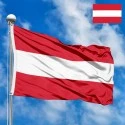

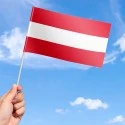


 Sizes:
Sizes:
 Sizes:
Sizes:
